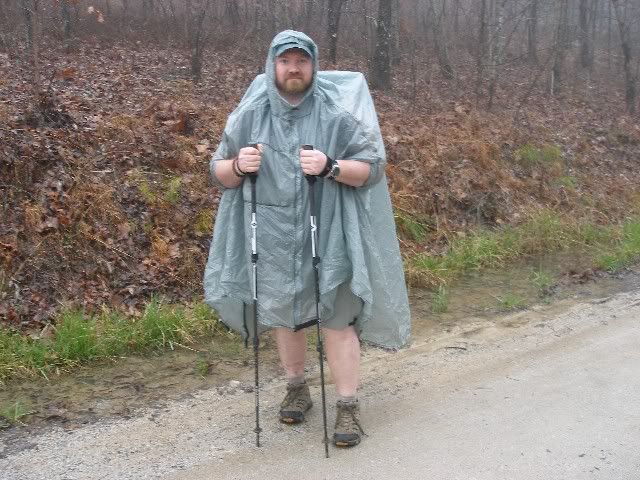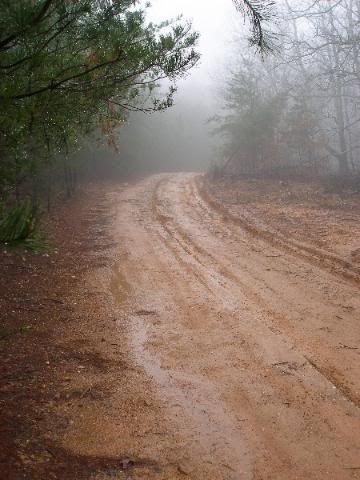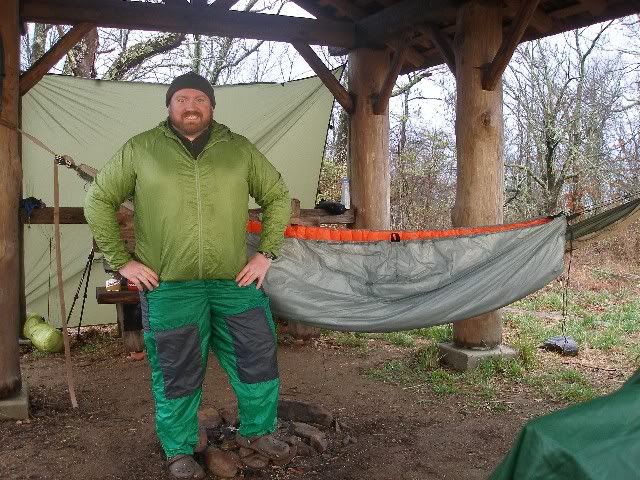Monday morning of last week, I started a section of the Pinhoti Trail at Bull Gap near Sylacauga, Alabama.

I loved the irony of the main trail corridor being blue-blazed.

Unfortunately, the pack straps almost immediately began putting enough pressure to my shoulder and chest that a minor muscle pull from the previous week suddenly inflamed badly. I figured as I warmed up, the pain would go away. But even after ibuprofen and cool rain, the throb and occasional shot of pain would hit my chest and shoulder and radiate into my elbow. Still the trail itself was nice enough that I walked on, accepting some discomfort for the joy of a good walk.
Between the pain in my chest and the rain, I tended to ease my head down and carry on. After three hours of non-stop walking, I found myself tired and hoping for a decent break from the rain so I could stop for lunch. Now, true trail magic smiled on me. A dry, wind-sheltered area for a pleasant lunch break.

After a pleasant rest and a bit more ibuprofen, I packed up and headed on. I had planned on heading perhaps as far as Scott Lake, 14 miles in, but for now had my sights set on the picnic shelter at Horn Mountain. At least I would get a bit of a break from the rain. Heath Cliffs, which I imagine normally offers a fantastic view, was a no-verlook in the mist.

Disappointed with no views, I chose to blue-blaze the blueblazes the remaining mile and change to Horn Mountain by walking FS Road 600.

The cold rain, wind, and ibuprofen finally numbed my shoulder to the point where I ate up the distance quickly. The firetower had its lower stairway removed to prevent folks from climbing it.

However, the picnic shelter was reasonably dry. Of course, it was also fairly windy and I rigged my tarp up to provide a windbreak while I heated some water. Though it was early, only a little after 2PM, I decided I was going to sit tight until it stopped raining. Weather reports that morning declared the rain was supposed to end that afternoon. So I kept my options open while I cooked dinner early and hoped to push on to a later campsite in the remaining hours of daylight.
No luck. At 6:45, with less than half an hour of daylight left and rain still coming down, I strung my hammock and prepared to settle in for the night.

I slept very well and awoke to a clear sunrise with very little tension in my shoulder and chest. Packing up, I bushwhacked the 300 yards or so down to the Pinhoti Trail and continued on. Unfortunately the pain was quick to return. I trundled on until I reached the fantastic views at Wormy's Pulpit.

I stopped, rested, took still more ibuprofen, and enjoyed myself for a few minutes. Unlike the day before, the rest did not relieve the pain in my shoulder. I had planned to hike another three days and 40 miles, but I began to have serious doubts.
I continued on toward Scott Lake. I was glad to have waited until a warmer sunny day to cross the outlet stream from Scott Cascade.

The actual crossing point wasn't too terribly deep, just upper calf, but the water was screaming past. I was very glad I had waited another day to cross. The shock of the cold water actually took my mind off my chest for a bit.
But at this point, I had pretty much decided my section hike would end at Porter Gap, another 3 1/2 miles up the trail. I was able to contact my wife who was staying with her parents just a little over an hour away.
The trail, which was already very pleasant, became an amazingly mellow series of sidehill cuts, edging around finger after finger of land. Instead of routing a hiker over one finger after another, the designers and builders had built an almost pefectly level walk to Porter's Gap.

I was incredibly grateful for the hard work that went into an easy walk to the trailhead. By the time I got there, I was no longer using my right trekking pole because the arm was too pained from heat radiating into it. But the next couple days of rest helped tremendously. I hope to be back to my normal hiking regimen soon, and I'm definitely looking forward to returning to the Pinhoti Trail in the fall.







 Reply With Quote
Reply With Quote

Bookmarks